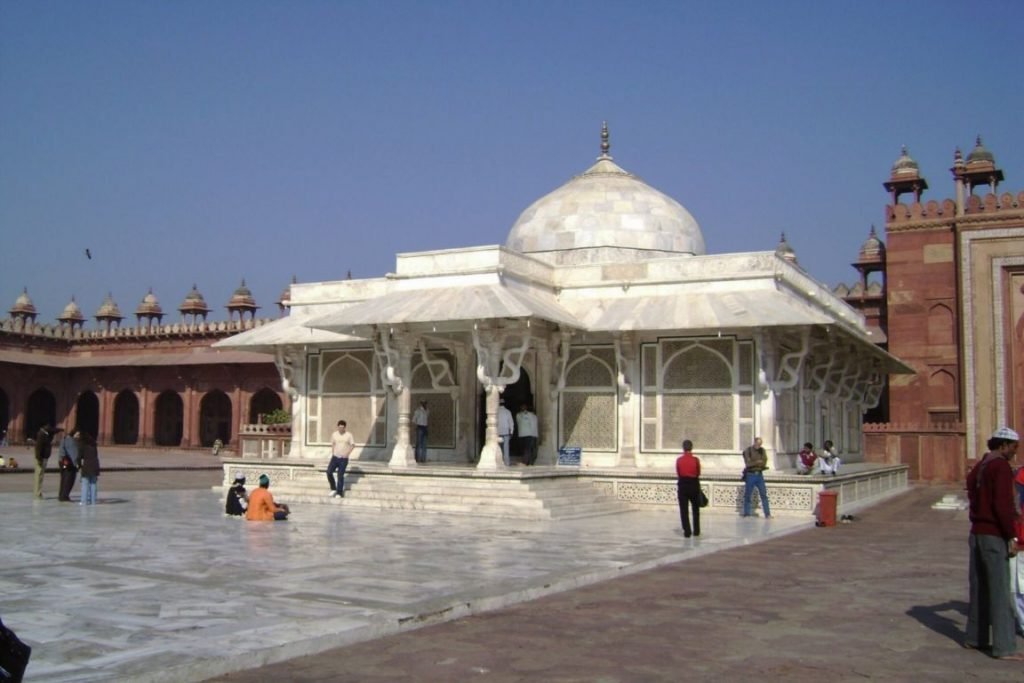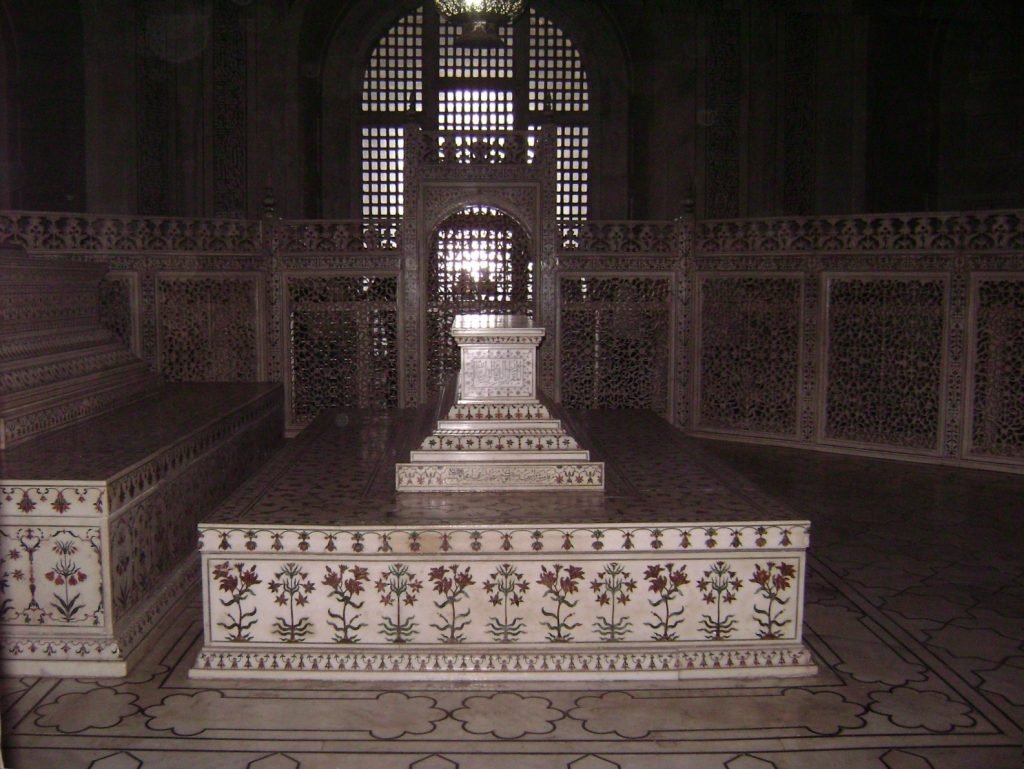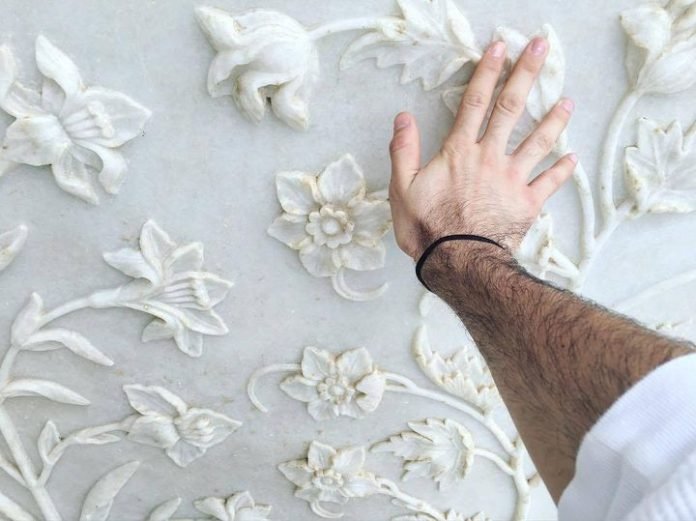The Taj Mahal’s white marble is a defining feature of this iconic mausoleum and one of the most striking examples of its use in architecture. The Taj Mahal white marble used in the construction of the Tomb of Mumtaj is among the finest in the world, and its luminous quality and intricate designs have captured the imagination of visitors for centuries.
The Taj Mahal white marble used in the Taj Mahal was sourced from quarries in Makrana, a town located in the Indian state of Rajasthan. This marble is known for its purity, whiteness, and fine texture, and is considered to be some of the best quality marble in the world. The white marble was transported to Agra, the site of the Taj Mahal, by a fleet of elephants, a process that took several years.
you also like to read: Discover the Timeless Beauty of Agra with a Local Guide: Unveiling the Secrets of the Taj Mahal and Beyond!
The use of white marble in the Taj Mahal was a deliberate choice by the Mughal emperor Shah Jahan, who wanted to create a monument that would be both beautiful and symbolic of his love for his wife. The Taj Mahal’s white marble was chosen for its luminous quality, which is particularly evident at dawn and dusk when the building seems to glow with a golden light.

Delhi Agra one day tour by Car – Book with Local From ₹ 6,500
Delhi Agra one day tour by Car Inclusive of neat and clean Car with Experienced Driver + Local Live Guide on Additional cost – Check Out More!
View DetailsThe Taj Mahal white marble used in the wonder of the world was carefully cut and polished to achieve the smooth surface and intricate designs that are visible today. The Taj Mahal white marble work on the walls and arches of the Taj Mahal is some of the most intricate and beautiful in the world and includes floral motifs, geometric patterns, and calligraphy from the Quran.
“The Taj Mahal white marble used in the Taj Mahal was sourced from quarries in Makrana, a town located in the Indian state of Rajasthan.”
The white marble is also complemented by the use of black marble inlays, which add contrast and depth to the designs on the walls and arches. The inlays are made of precious and semi-precious stones, including jasper, onyx, and agate, and are arranged in intricate patterns that enhance the beauty and complexity of the Taj Mahal’s white marble work.
The use of white marble in the Taj Mahal has contributed to its enduring popularity and appeal and has made it one of the world’s most recognized and admired buildings. The luminous quality of the Taj Mahal’s white marble, combined with the intricate designs and careful craftsmanship, creates a sense of timelessness and beauty that continues to inspire awe and admiration in visitors from around the world.
The Taj Mahal’s white marble is a defining feature of this iconic mausoleum and a testament to the skill and artistry of the craftsmen who built it. Its luminous quality, intricate designs, and careful craftsmanship have made the Taj Mahal one of the most beautiful and admired buildings in the world and a symbol of India’s rich cultural heritage.
What other materials were used in Mughal architecture?
Mughal architecture is known for its grandeur, complexity, and use of a variety of materials. In addition to The Taj Mahal’s white marble, which was a favored material of the Mughals, other materials commonly used in Mughal architecture include:
Red sandstone: Red sandstone is a type of sedimentary rock that was used extensively in Mughal architecture, especially in buildings such as forts, palaces, and mosques. The red sandstone used in Mughal architecture was often sourced from the quarries in the region of Fatehpur Sikri, near Agra.

Limestone: Limestone was another common building material in Mughal architecture, particularly for the construction of plinths, columns, and other structural elements. The limestone used in Mughal architecture was often sourced from the quarries in the region of Chunar, near Varanasi.
Granite: Granite, a hard and durable igneous rock, was also used in Mughal architecture, particularly for the construction of pillars, lintels, and doorways. The granite used in Mughal architecture was often sourced from the quarries in the region of Rajasthan.
Brick: Brick was a widely used building material in Mughal architecture, particularly for the construction of walls, arches, and domes. The bricks used in Mughal architecture were often made from clay and baked in kilns.
Wood: Wood was used in Mughal architecture for decorative elements such as screens, doors, and balconies. The Mughals were known for their skill in carving wood, and many of the wooden elements in their buildings are intricately decorated with floral motifs and geometric patterns.
In addition to these materials, Mughal architecture also often incorporated decorative elements such as tiles, inlays, and carvings made from precious and semi-precious stones, including jade, lapis lazuli, and turquoise. The use of these materials and decorative elements helped to create the intricate and beautiful designs that are characteristic of Mughal architecture.
“The Taj Mahal is the most famous example of Mughal architecture that uses The Taj Mahal’s white marble.”
What are some examples of Mughal buildings that used The Taj Mahal’s white marble?
The Taj Mahal is the most famous example of Mughal architecture that uses The Taj Mahal’s white marble, but there are many other Mughal buildings that also feature this beautiful material. Here are some examples:
Agra Fort: The Agra Fort, also known as the Red Fort, is a UNESCO World Heritage Site located in Agra, India. It was built by the Mughal Emperor Akbar in the 16th century and was later expanded by his grandson Shah Jahan. The fort is made of red sandstone and Taj Mahal white marble, and the use of white marble is particularly evident in the Khas Mahal, a private palace within the fort that features intricate marblework on its walls, pillars, and arches.

Itimad-ud-Daulah’s Tomb: This is a Mughal-era mausoleum located in Agra, India, and is often referred to as the “Baby Taj” due to its resemblance to the Taj Mahal. It was built in the mid-17th century by the Mughal Empress Nur Jahan as a tribute to her father and features extensive use of the Taj Mahal white marble, including intricate inlays and carvings.
Jama Masjid: The Jama Masjid is a mosque located in Delhi, India, and was built by the Mughal Emperor Shah Jahan in the 17th century. The mosque features a large central courtyard and an impressive facade made of red sandstone and Taj Mahal white marble. The Taj Mahal’s white marble is particularly evident in the mosque’s three domes, which are adorned with intricate carvings and inlays.
“The use of the Taj Mahal white marble in Mughal architecture was a defining feature of the era, and its luminous quality and intricate designs continue to inspire awe and admiration in visitors from around the world.”
Akbar’s Tomb: This is a Mughal-era mausoleum located in Sikandra, near Agra, India. It was built by the Mughal Emperor Akbar in the late 16th century and features a blend of architectural styles, including elements of Hindu, Islamic, and Persian design. The tomb is made of red sandstone and Taj Mahal white marble, and Taj Mahal white marble is used extensively in its intricate carvings and inlays.
These are just a few examples of the many Mughal buildings that feature The Taj Mahal’s white marble. The use of the Taj Mahal white marble in Mughal architecture was a defining feature of the era, and its luminous quality and intricate designs continue to inspire awe and admiration in visitors from around the world.
What is the history behind the use of the Taj Mahal’s White Marble in Mughal architecture?
The use of the Taj Mahal’s White Marble in Mughal architecture has a long and rich history that is tied to the cultural and artistic traditions of the Mughal Empire. The Mughals were a Muslim dynasty that ruled India from the 16th to the 19th century, and they were known for their love of art, literature, and architecture.
The use of the Taj Mahal’s White Marble in Mughal architecture can be traced back to the reign of the Mughal Emperor Akbar (r. 1556-1605), who was known for his patronage of the arts and his interest in architecture. Akbar was particularly interested in the use of the Taj Mahal’s White Marble, which he saw as a symbol of purity and divine perfection. He commissioned several buildings that incorporated white marble, including the mausoleum of his father, Humayun, in Delhi, which features extensive use of white marble in its intricate carvings and inlays.
Akbar’s grandson, Shah Jahan (r. 1628-1658), is perhaps the most famous patron of the Taj Mahal’s White Marble in Mughal architecture. Shah Jahan is best known for commissioning the Taj Mahal, a mausoleum built in memory of his beloved wife, Mumtaz Mahal. The Taj Mahal is made almost entirely of white marble, and its intricate designs and delicate carvings are among the finest examples of Mughal architecture.

The use of the Taj Mahal White Marble in Mughal architecture continued to be popular throughout the 17th and 18th centuries, with many buildings incorporating the material in their designs. The Taj Mahal White Marble used in Mughal architecture was often sourced from the quarries in the region of Makrana, in the Indian state of Rajasthan, which was known for producing some of the finest quality Taj Mahal White Marble in the world.
You also like to read: Experience the Magic of Taj Mahal at Sunset with an Exclusive Boat Ride in Agra!
The Mughals were also known for their skill in working with marble, and the artisans who built their buildings were renowned for their craftsmanship and attention to detail. The use of white marble in Mughal architecture was not only an aesthetic choice, but it was also a symbol of the dynasty’s power, wealth, and artistic vision.
The use of white marble in Mughal architecture has a rich and complex history that is tied to the cultural and artistic traditions of the Mughal Empire. The Mughals saw white marble as a symbol of purity, beauty, and divine perfection, and they used it extensively in their buildings as a way to express their power, wealth, and artistic vision. The intricate designs and delicate carvings of Mughal architecture continue to inspire awe and admiration in visitors from around the world, and the use of white marble remains a defining feature of this iconic style.



































